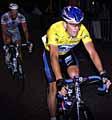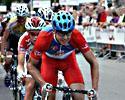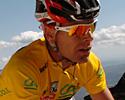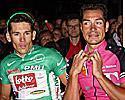
Recently on Cyclingnews.com |
Fixed for the fans - the post-TdF criteriums
A race where the outcome is known before the start? Surely not! Well, yes. The series of races generically known as 'post-Tour crits' provide the cycling-mad fans in Belgium, Holland and Germany with an opportunity to get close to the stars of the Tour de France. Jeff Jones provides an overview of these races where the outcome is known before the start.
(BELGIUM, August 8, 2002): The post-Tour criterium circuit is currently in full swing, usually taking place over the two weeks following the completion of the Tour de France. The popular races are held in most countries, in towns such as Boxmeer, Stiphout, Chaam, Heerlen, Roosendaal, Surhuisterveen, Oostvoorne, Pijnacker (Netherlands), Aalst, Geraardsbergen, Peer (Belgium), Dortmund, Rhede, Duisberg, Hannover (Germany), Camors, Liseaux (France), Herning (Denmark), Graz (Austria), and this year for the first time, New York (USA).
The latter is a bit of an anomaly in the sense that the race isn't decided before the start. What? Fixing races?!? A shocking state of affairs! It would never happen in my day - I suppose you're going to tell me that Santa Claus isn't real next? Rumour has it that you can even place bets on these races, although you have to be quick to collect your money afterwards...
 |
It should be remembered that these races are a public spectacle, where thousands of fans can see their heroes in person, after just having completed their three weeks of suffering in France. Although some of the riders don't earn a great deal of prize money during the Tour, they can make up for that by riding the post Tour criterium circuit. Jersey winners (Lance Armstrong) or big name riders (Mario Cipollini) can earn between 20 and 60 thousand euros per race in start money, while the rest of the pack has to make do with the pickings, which are still better than nothing.
Rabobank's Addy Engels commented to the Amersfoortse Courant about why the riders chose to race in these "spectacles" so soon after finishing an enormously taking three week bicycle race. "You have to train, even after the Tour. If you don't do anything for two or three days you have problems. And what is better than training at night and they even pay for it? It's like looking at monkeys. There aren't too many sporting heroes who are on television for three weeks. You can follow them very closely. And the audience wants to see them live."
 |
The budget of a criterium such as the Ronde van Boxmeer is 135,000 euro. Most of this budget goes to the riders. If someone like Armstrong costs 60,000 euro, and the Dutch super trio of Erik Dekker, Michael Boogerd and Karsten Kroon another 35,000 euro, the organiser has to make a choice as to how many (and which) Tour riders he wants, to try and keep everyone happy. In the heyday of Dutch post Tour crits 25 years ago, there were 96 races on offer. Now there are only 12.
"It would be hypocritical to say that I do this for fun," said Michael Boogerd. "It's my job and I get a lot of money for it. And there are a lot of kids who can't go to France to see us. I know it; when I was I kid I was very enthusiastic about seeing the riders for real. Cycling is a real sport for the working class people; that's the power of our sport."
Before the advent of high base salaries, post-Tour criteriums used to be an important part of a rider's program, as they could earn a lot more money in proportion to their normal salaries. Top Dutch criterium manager Gerry van Gerwen says "But since cycling is a television sport, the base salaries are good enough, and the criteriums can come in second place. It's more a publicity exercise. The riders get applause, get recognition and promote their own brand."
He equates doing criteriums as the same as a singer who is famous on TV doing a world tour. "A criterium brings the riders to the people. You can see them, smell them and touch them," he said.
 |
What goes down?
So how do they manage to 'fool' the public into believing that a real race is happening? Although it should be blatantly obvious from the results - how often would Lance Armstrong beat Mario Cipollini and Giovanni Lombardi in a criterium, for example? But these are professionals, and they know how to put on a good show.
In the early laps, when the pace is not so high, they will let a local favourite go to please the crowd. Meanwhile, the rest of the peloton will grimace in pain as though they are giving it everything to chase the local rider down, eventually succeeding at a (perceived) huge cost of energy. These guys can ride criteriums at over 50 km/h if they want, so the speed doesn't have to be that low to make it look good for the public.
Addy Engels puts it this way. "Don't forget, we do 100 kilometres mostly in under 2.5 hours - mostly above 40 km/h. So it isn't that easy. Tactics aren't the most important part of these races. But present yourself to the audience, that is. People come for their fun, they want to see the big shots and a nice race. And we take care that they get what they want.
Allowing for the fact that the top three are usually pre-determined, the rest of the placings can be fought out in earnest. So, some genuine racing actually does happen amongst the pro's at these events. There's also the various support races, with the amateurs, women, juniors and masters, who are free to race as hard as they like, while the crowd gradually drowns itself in the local beverage of choice.
 |
This brings us to an important point. In many European countries (Belgium springs to mind for some reason), the carnival or 'feest' is a big and very ingrained part of the culture. Folks like to have fun, and having a sideshow of bicycle racing to go with their beer is an ideal form of entertainment. It's relatively quiet (depending on the PA system), but fast and exciting enough to capture the attention.
Criteriums and kermesses, cyclocross races and track races are all very much spectator friendly cycling events. Road races aren't nearly as spectator friendly, unless there are finishing circuits or a publicity caravan to keep the crowds amused while they wait for their 30 seconds of action. They work, because people can still enjoy a day out in the fresh air with other like-minded folks. The Tour de France takes this to an extreme, as evidenced by the enormous crowds en route. As far as the racing is concerned, anyone can see it better on TV, but the atmosphere of being there is something that is very hard to capture on the box.
Criteriums provide this and more, because you can watch the best riders, as well as having a convenient place to party on into the night. They are for the most part free to watch (except for Draai van der Kaai in Rooosendaal which is 12 euros per person). The good guys win and everyone is happy. There's still an element of unpredicability about them anyway, as most of those watching will not have access to the winner's list.

